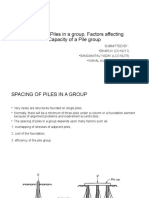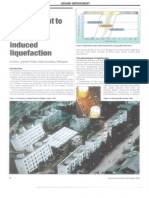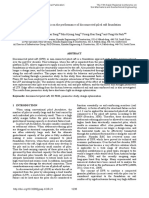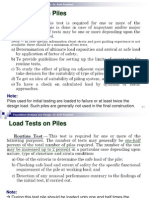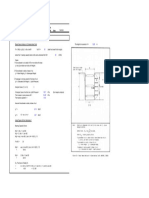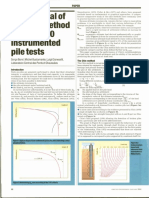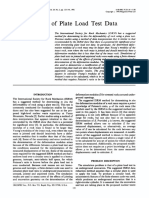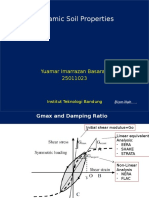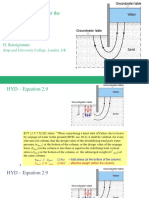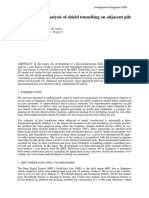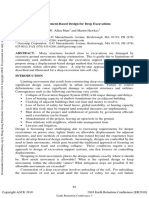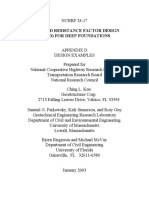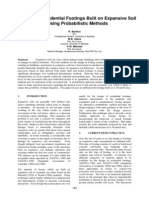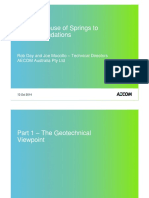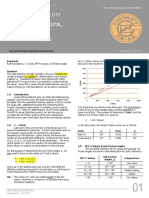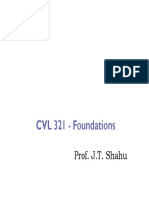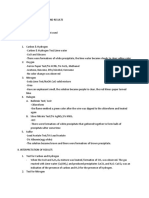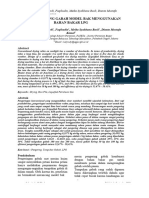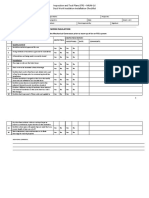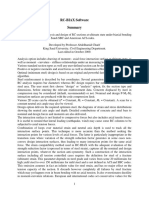Use and Abuse of Springs to
Model Foundations
Rob Day and Joe Muccillo Technical Directors
AECOM Australia Pty Ltd
13 Oct 2014
�Part 1 The Geotechnical
Viewpoint
�Outline
- What is the conflict?
- The limitations of spring models to represent soil
continuum
- The plate load test
- Behaviour of footings/rafts
- Behaviour of vertically loaded piles and pile groups
- Behaviour of laterally loaded piles and pile groups.
- Behaviour of propped sheetpile excavations
Use and Abuse of Springs
March 16, 2016
Page 3
�Whats the conflict?
�Conflicting points of view
Structural Engineer:
SPRING CONSTANT
Use and Abuse of Springs
March 16, 2016
Page 5
�Conflicting points of view
Structural Engineer:
Geotechnical Engineer:
SPRING CONSTANT
MODULUS OF SUBGRADE
REACTION (HIGHLY
VARIABLE WITH
GEOMETRY/LOAD)
Use and Abuse of Springs
March 16, 2016
Page 6
�Conflicting points of view
Geotechnical Engineer:
DEFLECTIONS UNDER
KNOWN LOAD AND
GEOMETRY
Use and Abuse of Springs
March 16, 2016
Page 7
�Conflicting points of view
Structural Engineer:
Geotechnical Engineer:
DEPENDS ON FOUNDATION
STIFFNESS
DEFLECTIONS UNDER
KNOWN LOAD AND
GEOMETRY
Use and Abuse of Springs
March 16, 2016
Page 8
�Conflicting points of view
Structural Engineer:
Geotechnical Engineer:
DEPENDS ON FOUNDATION
STIFFNESS
DEFLECTIONS UNDER
KNOWN LOAD AND
GEOMETRY
NEED TO REACH
A COMPROMISE
Use and Abuse of Springs
March 16, 2016
Page 9
�A typical foundation scenario
Use and Abuse of Springs
March 16, 2016
Page 10
�Typical Spring Constant Examples
RAFT
LATERAL
PILE
FRAME SUPPORT
Use and Abuse of Springs
March 16, 2016
Page 11
�Why do Geotechnical Engineers HATE Springs?
- Soil does not behave like a spring
- The bigger the loaded area the softer the elastic response
per unit area
- Soil behaves inelastically from quite low stress levels and
undergoes extensive plastic yield at higher stresses.
- Hence there is a fear that springs will be used for other
than intended purpose.
Use and Abuse of Springs
March 16, 2016
Page 12
�Typical settlement contours under a loaded area
Use and Abuse of Springs
March 16, 2016
Page 13
�Footings and Rafts
�Uniform load on a raft supported by springs
UNIFORM LOAD q
Ks
Use and Abuse of Springs
March 16, 2016
Page 15
�Soil springs from textbooks
Soil
Loose sand
Medium dense sand
Ks, kN/m3
4800 -- 16000
9600 -- 80000
Dense sand
Clayey medium
dense sand
Silty medium dense
sand
Clayey soil
64000 128000
32000 80000
qu 200 kPa (4 ksf)
Bowles - Foundation
Analysis and Design
5th Ed
- The modulus of subgrade reaction
(Ks)
- The units are pressure/deflection
e.g. kPa/m
- Typical values from Bowles book
24000 -- 48000
12000 24000
Clayey soil
200 < qu 400 kPa
24000 48000
Clayey soil
qu > 800 kPa
Use and Abuse of Springs
> 48000
March 16, 2016
Page 16
�Structural Engineer:
EASY! WHATS
THE PROBLEM?
Use and Abuse of Springs
March 16, 2016
Page 17
�Uniform load on a raft supported by springs
UNIFORM LOAD q
d=q/Ks
Ks
Use and Abuse of Springs
March 16, 2016
Page 18
�Uniform load on a raft supported by springs
UNIFORM LOAD q
d=q/Ks
Ks
CONSTANT LOAD AND DEFLECTION ON
ALL SPRINGS IRRESPECTIVE OF RAFT
SIZE/STIFFNESS
NO BENDING!
Use and Abuse of Springs
March 16, 2016
Page 19
�Modulus of Subgrade Reaction Plate Load Test
Typically 0.3m diameter
Use and Abuse of Springs
March 16, 2016
Page 20
�Uniform load on a RIGID circular plate
UNIFORM LOAD q = 100kPa
0.3m diameter (D)
E = 10MPa,
u = 0.3,
c, f = ? Assume elastic
Semiinfinite soil
Use and Abuse of Springs
March 16, 2016
Page 21
�Elastic pressure response - Theoretical
Half of average
Asymptotes to
infinite
Use and Abuse of Springs
March 16, 2016
Page 22
�Elastic pressure response Finite Difference
Av. 300kPa
Use and Abuse of Springs
March 16, 2016
Page 23
�Elastic pressure response - Theoretical
0.6 x average
1.8 x average
Use and Abuse of Springs
March 16, 2016
Page 24
�Elastic plastic response for a stiff clay
Average pressure
Plastic yield
starts at edge:
zero for granular,
~ 2cu for cohesive
Use and Abuse of Springs
March 16, 2016
Page 25
�Elastic plastic response for a stiff clay
Average pressure
Progressive yield
Ultimate bearing pressure
Use and Abuse of Springs
March 16, 2016
Page 26
�Elastic plastic response for a stiff clay
Ks = 47,000kN/m3
Integrate area under pressure curve
Use and Abuse of Springs
March 16, 2016
Page 27
�Elastic plastic response Finite Difference
0.3m Rigid Plate E=10MPa v=0.3
30
25
average 300kPa
Load (kN)
20
elastic
15
surface sand phi=35
100mm deep san d phi=35
10
clay cu=50 v=0.3
average 140kPa
average 100kPa
0
0 1 2 3 4 5 6 7 8 9 10 11 12 13 14 15 16 17 18 19 20
Displacement (mm)
Use and Abuse of Springs
March 16, 2016
Page 28
�Elastic plastic response Finite Difference
Use and Abuse of Springs
March 16, 2016
Page 29
�Elastic plastic response Finite Difference
SAND 6mm Deflection Av 100kPa
Ground
heaving
Use and Abuse of Springs
March 16, 2016
Page 30
�Elastic plastic response Finite Difference
SAND 6mm Deflection Av 100kPa
Use and Abuse of Springs
March 16, 2016
Page 31
�Elastic plastic response Finite Difference
CLAY 14mm Deflection Av 280kPa
v=0.3 (bigger for v=0.5)
Use and Abuse of Springs
March 16, 2016
Page 32
�Effect of footing size
Use and Abuse of Springs
March 16, 2016
Page 33
�Effect of footing size
3m pad has 1/10 Ks of 0.3m pad
Use and Abuse of Springs
March 16, 2016
Page 34
�For a RIGID CIRCULAR plate at LOW STRAINS
. .(
i.e. INVERSELY PROPORTIONAL
TO DIAMETER OF CIRCLE (D)
Use and Abuse of Springs
March 16, 2016
Page 35
�RIGID CIRCLE VARY DIAMETER FINITE DIFFERENCE
Av 300kPa
0.3m dia. 6mm
Av 300kPa
0.6m dia. 11mm
Use and Abuse of Springs
March 16, 2016
Not double
As rigid
boundaries
at 1.2m
Page 36
�Settlement of RIGID irregular shape
50mm
35mm
10m
Use and Abuse of Springs
March 16, 2016
Page 37
�Settlement of RIGID irregular shape
Using a uniform spring analogy a uniform load would settle
by an equal amount at all springs
UNIFORM LOAD q
d=q/Ks
Ks
Use and Abuse of Springs
March 16, 2016
Page 38
�Settlement of a FLEXIBLE raft
Av 300kPa
RIGID
300kPa
FLEXIBLE
Use and Abuse of Springs
March 16, 2016
Page 39
�Settlement of a FLEXIBLE raft
1m Thick
Raft
Use and Abuse of Springs
March 16, 2016
Page 40
�Superposition of load
Why does this happen?
Need to understand how the soil and loads interact
Consider a uniform flexible strip load on a deep soil
UNIFORM LOAD = 100kPa
1m wide
strip
E = 10MPa,
u = 0.3,
c, f = ? Assume elastic
Semiinfinite soil
Use and Abuse of Springs
March 16, 2016
Page 41
�Single 1m wide strip
Settlement bowl
extends way
beyond footing
Edge of footing
Use and Abuse of Springs
March 16, 2016
Page 42
�Nine 1m wide strip loads at 2.5m centres
Use and Abuse of Springs
March 16, 2016
Page 43
�Settlement of a strip footing line load
LINE LOAD
P = 100kN/m
d = 22mm
0.5m wide
strip
LINE LOAD
P = 100kN/m
d = 22mm
E = 10MPa,
u = 0.3,
c, f = ? Assume elastic
Semiinfinite soil
Use and Abuse of Springs
March 16, 2016
Page 44
2m wide
strip
�RIGID STRIP VARY WIDTH FINITE DIFFERENCE
30kN/m (100kPa)
0.3m strip 5.8mm
30kN/m (50kPa)
0.6m strip. 4.5mm
Not same
As rigid
boundaries
at 3m
Use and Abuse of Springs
March 16, 2016
Page 45
�Settlement of a FLEXIBLE raft is superposition of many
small square loads
1m Thick
Raft
Use and Abuse of Springs
March 16, 2016
Page 46
�Effect of finite soil depth or layering
UNIFORM LOAD = 100kPa
Width B=1m
Depth H
E = 10MPa,
u = 0.3,
c, f = ? Assume elastic
Rigid Base
Use and Abuse of Springs
March 16, 2016
Page 47
�Real Soils not linear elastic purely plastic
- High modulus at very small strains
- Brittle, strain hardening and strain softening behaviour
- Time dependent consolidation
Use and Abuse of Springs
March 16, 2016
Page 48
�Consolidation with time
pressure (kPa)
2000
1
1500
0%
1000
2%
500
4%
0
0
500
1000
1500
2000
2500
3000
3500
6%
time (min)
500
1000
time (min)
1500
2000
2500
strain
0%
3000
3500
Strain
8%
10%
12%
5%
14%
10%
16%
15%
18%
20%
20%
Use and Abuse of Springs
March 16, 2016
Page 49
10
pressure
100
1000
10000
�Non linear stress-strain behaviour
Use and Abuse of Springs
March 16, 2016
Page 50
�Conclusions for spread footings and rafts
- At low strains spring stiffness
much higher around edges
than in middle
- Hence higher bending
moments (typically 2 to 3 times
higher for stiff footings at low
strains)
- For eccentric loads uniform
springs over-estimate rotation
(typically by 2 to 4 times)
Use and Abuse of Springs
March 16, 2016
Page 51
�Conclusions for spread footings and rafts
- Springs go plastic at lower
stresses near edge than in
middle
- Spring stiffness HIGHLY
DEPENDENT on size of
loaded area
Use and Abuse of Springs
March 16, 2016
Page 52
�Conclusions for spread footings and rafts
- Shape of raft affects spring
stiffness distribution
- Adjacent footings can have a
very significant effect on
settlement
Use and Abuse of Springs
March 16, 2016
Page 53
�Spring Recommendations For Footings/Rafts:
- DONT use uniform springs
- Vary springs to take into account size and shape of
footing, proximity of other footings and location of spring
relative to centroid and perimeter of raft
- (as a rule of thumb edge spring is about double centre
springs and corner springs three to four times middle
springs for deep uniform soils).
- Check for highly loaded springs that may have gone
plastic and replace with loads when appropriate.
- ITERATIVE PROCESS BETWEEN STRUCTURAL AND
GEOTECHNICAL DESIGNERS.
Use and Abuse of Springs
March 16, 2016
Page 54
�Axially Loaded Piles and Pile Groups
�Single axially loaded pile
Use and Abuse of Springs
March 16, 2016
Page 56
�Interaction between two identical rigid axially loaded
piles
Poulos and Davis
Elastic Solutions
Use and Abuse of Springs
March 16, 2016
Page 57
�Interaction between two identical rigid axially loaded
piles
Poulos and Davis
Elastic Solutions
Two identically loaded floating
piles 3 diameters apart settle
approximately 1.5 times as
much as a single pile
Use and Abuse of Springs
March 16, 2016
Page 58
�Consider a group of 25 piles at 3D floating in a stiff clay
soil single pile 5mm settle at 500kN
Use and Abuse of Springs
March 16, 2016
Page 59
�Centre pile settles approx
10 times as much as single pile
Use and Abuse of Springs
March 16, 2016
Page 60
�Group settles 9 times as much as single pile
Corner piles attract over double average load
Use and Abuse of Springs
March 16, 2016
Page 61
�Conclusions for Vertical Piles/Groups:
- Axial stiffness of a single pile is non linear from quite low
load levels
- Interaction effects of pile groups have similar issues to raft
footing interactions.
- Corner/end piles in rigid pilecaps tend to attract much
higher loads (although some pile yield can redistribute
load)
Use and Abuse of Springs
March 16, 2016
Page 62
�Spring Recommendations Vertical Piles/Groups:
- For groups of piles sharing a pilecap generally DONT use
uniform springs, especially if floating Need to do pile
group analysis.
- In practice for single pile supports more than about 10
diameters apart with high end bearing interaction tends to
be small
- Check for highly loaded springs that may have gone
plastic and replace with soft springs or loads when
appropriate.
- ITERATIVE PROCESS BETWEEN STRUCTURAL AND
GEOTECHNICAL DESIGNERS.
Use and Abuse of Springs
March 16, 2016
Page 63
�Laterally Loaded Piles and Pile Groups
�Laterally loaded piles
In some ways, a laterally loaded pile can be considered similar to
a strip footing.
BUT, the ground surface and the limit of passive resistance have a
major effect on stiffness near the surface
E = 10MPa,
u = 0.3,
c, f = ? Assume elastic
Use and Abuse of Springs
March 16, 2016
Page 65
�Effect of pile diameter
Remember footing width relationship:
Use and Abuse of Springs
March 16, 2016
Page 66
�Effect of pile diameter
- Doubling the pile diameter halves pressure for a given
load
- BUT doubling diameter also halves modulus of subgrade
reaction.
- => Net effect is CHANGING PILE DIAMETER DOES
NOT CHANGE THE STIFFNESS of the equivalent spring
in the elastic range.
K = (0.8 to 1.8) Es
where Es in MPa and
K is a spring stiffness in MN/m per metre of pile length
- BUT diameter does increase the passive pressure limit.
Use and Abuse of Springs
March 16, 2016
Page 67
�Effect of pile diameter
P
Ks=
P/d
Ks=
P/d
Use and Abuse of Springs
March 16, 2016
Page 68
�SINGLE Lateral loaded pile
Passive limit has big effect particularly in sand
D
SAND
K~Es
CLAY
Pmax = 2cuD
Pmax =
3KpgD
3D
Pmax = 9cuD
Use and Abuse of Springs
March 16, 2016
Page 69
�Single pile in clay analogy to plate load test
Use and Abuse of Springs
March 16, 2016
Page 70
�Laterally loaded pile groups analogy with strip footings
Use and Abuse of Springs
March 16, 2016
Page 71
�Interaction between lateral and vertical stiffness
H
displace
>>x
Use and Abuse of Springs
March 16, 2016
displace=x
Page 72
�Spring Recommendations Lateral Piles/Groups:
- Same spring irrespective of pile diameter
- Very sensitive to passive limits hence replace springs with
loads in upper parts of piles
- Must consider softer springs for rows of piles.
- Need to also use vertical springs to check mode of
bending
- ITERATIVE PROCESS BETWEEN STRUCTURAL AND
GEOTECHNICAL DESIGNERS.
Use and Abuse of Springs
March 16, 2016
Page 73
�Ground movement induced loading
Propped Flexible Retaining Walls
�Multi-propped, staged diaphragm wall in sand
Use and Abuse of Springs
March 16, 2016
Page 75
�Excav. to elev. -3.00 on PASSIVE side
Net Pressure (kPa)
20
-30
-80
60
0
-20
-60
displacement (m)
-100 -140 -180 -220
0
0.000
0
-2
-2
-4
-4
-4
-6
-6
-6
-8
-8
-8
Depth (m)
-2
-10
Use and Abuse of Springs
20
-10
Depth (m)
70
Moment (kNm/m)
Depth (m)
Stage 3
-10
-12
-12
-12
-14
-14
-14
-16
-16
-16
-18
-18
-18
-20
-20
March 16, 2016
Page 76
-20
0.005
0.010
0.015
0.020
�Excav. to elev. -6.00 on PASSIVE side
Net Pressure (kPa)
20
-30
-80
60
0
-20
-60
displacement (m)
-100 -140 -180 -220
0
0.000
0
-2
-2
-4
-4
-4
-6
-6
-6
-8
-8
-8
Depth (m)
-2
-10
Use and Abuse of Springs
20
-10
Depth (m)
70
Moment (kNm/m)
Depth (m)
Stage 5
-10
-12
-12
-12
-14
-14
-14
-16
-16
-16
-18
-18
-18
-20
-20
March 16, 2016
Page 77
-20
0.005
0.010
0.015
0.020
�Excav. to elev. -9.00 on PASSIVE side
Net Pressure (kPa)
20
-30
-80
60
0
-20
-60
displacement (m)
-100 -140 -180 -220
0
0.000
0
-2
-2
-4
-4
-4
-6
-6
-6
-8
-8
-8
Depth (m)
-2
-10
Use and Abuse of Springs
20
-10
Depth (m)
70
Moment (kNm/m)
Depth (m)
Stage 7
-10
-12
-12
-12
-14
-14
-14
-16
-16
-16
-18
-18
-18
-20
-20
March 16, 2016
Page 78
-20
0.005
0.010
0.015
0.020
�Excav. to elev. -12.00 on PASSIVE side
Net Pressure (kPa)
20
-30
-80
60
0
-20
-60
displacement (m)
-100 -140 -180 -220
0
0.000
0
-2
-2
-4
-4
-4
-6
-6
-6
-8
-8
-8
Depth (m)
-2
-10
Use and Abuse of Springs
20
-10
Depth (m)
70
Moment (kNm/m)
Depth (m)
Stage 9
-10
-12
-12
-12
-14
-14
-14
-16
-16
-16
-18
-18
-18
-20
-20
March 16, 2016
Page 79
-20
0.005
0.010
0.015
0.020
�Excav. to elev. -15.00 on PASSIVE side
Net Pressure (kPa)
20
-30
-80
60
0
-20
-60
displacement (m)
-100 -140 -180 -220
0
0.000
0
-2
-2
-4
-4
-4
-6
-6
-6
-8
-8
-8
Depth (m)
-2
-10
Use and Abuse of Springs
20
-10
Depth (m)
70
Moment (kNm/m)
Depth (m)
Stage 11
-10
-12
-12
-12
-14
-14
-14
-16
-16
-16
-18
-18
-18
-20
-20
March 16, 2016
Page 80
-20
0.005
0.010
0.015
0.020
�All props wished into place and excavation in single stage
Net Pressure (kPa)
-30
-80
60
0
-20
-60
displacement (m)
-100 -140 -180 -220
0
0.000
0
-2
-2
-4
-4
-4
-6
-6
-6
-8
-8
-8
Depth (m)
-2
-10
Use and Abuse of Springs
20
-10
Depth (m)
20
Depth (m)
70
Moment (kNm/m)
-10
-12
-12
-12
-14
-14
-14
-16
-16
-16
-18
-18
-18
-20
-20
March 16, 2016
Page 81
-20
0.005
0.010
0.015
0.020
�Spring Recommendations For Retaining Walls:
- Spring analogies are usually not suitable for retaining wall
design particularly when there are multiple construction
stages.
- Retaining wall analysis should generally be carried out by
geotechnical engineer first and then the structural
adequacy and compatibility/interaction checked.
- Waler and anchor design needs to consider 3D effects
- ITERATIVE PROCESS BETWEEN STRUCTURAL AND
GEOTECHNICAL DESIGNERS.
Use and Abuse of Springs
March 16, 2016
Page 82
�A case study in structural and
geotechnical iteration
The Second Gateway Bridge
�Sir Leo Hielscher Bridges Opened May 2010
Use and Abuse of Springs
March 16, 2016
Page 84
�Geology (North)
JOIN LINE
(NORTH) ABUTMENT B
SOFT ALLUVIUM
STIFF ALLUVIUM
GRAVEL
FAULT?
ERSECTING FAULTS
SOCKETTED PILES
Use and Abuse of Springs
DRIVEN OCTAGONAL PRESTRESSED PILES
March 16, 2016
Page 85
FLEXIBLE ROCK SOCKETS
�Geology (South)
(SOUTH)
JOIN LINE
2xVERTICAL EXAGGERATION
RESIDUAL/WEAK
ASPLEY-TINGALPA
SANDSTONE/SILTSTONE
WIDE FAULT
COAL SEAMS
BEDDING SHEAR
SPREAD FOOTINGS ON ROCK
Use and Abuse of Springs
STIFF ALLUVIUM
March 16, 2016
INTERSECTING FAULTS
BORED ROCK SOCKETTED PILES
Page 86
�Fault weathered to hard clay at Pier 1
Use and Abuse of Springs
March 16, 2016
Page 87
�Discovered in construction when structure finalised
- Wide fault zone weathered to hard clay was exposed in
part of the footing excavation.
- Plate load tests indicated bearing capacity and modulus
much lower than adopted in design.
- To avoid pier and deck redesign, resized footing to
provide adequate bearing capacity without significantly
changing rotational stiffness.
- Achieved using an eccentric footing.
- Iterative approach with sensitivity checks.
Use and Abuse of Springs
March 16, 2016
Page 88
�Revised Footing Design
Use and Abuse of Springs
March 16, 2016
Page 89
�Variable springs calibrated to 2D FE analysis
SETTLEMENT OF RIGID RECTANGULAR FOOTING ON AN ELASTIC LAYER OF FINITE DEPTH
Foundation spring stiffness calibrated against FEAR output for rigid vertically loaded footing of same dimensions
Displacements (mm)
New Gate wa y Bridge
pier 1 13x 11m footing on fault with 2-way loads
SLS (in service ) Case 246
3.575
2.925
14.0-15.0
2.275
13.0-14.0
12.0-13.0
1.625
1.00-1.10
0.90-1.00
11.0-12.0
0.975
0.80-0.90
10.0-11.0
0.325
0.70-0.80
0.60-0.70
Y (L) axis (m)
9.0-10.0
0.50-0.60
-0.325
8.0-9.0
0.40-0.50
-0.975
7.0-8.0
0.30-0.40
-1.625
0.20-0.30
-2.275
2.93
1.83
0.73
m
m
kNm
kNm
kN/mm
kNm2/mm
kNm2/mm
mm
mm/m
mm/m
kPa
kPa
mm
mm
mm
kPa
kPa
kPa
kPa
kPa
-0.38
6.0-7.0
5.0-6.0
4.0-5.0
-2.925
3.0-4.0
-3.575
2.0-3.0
-4.225
1.0-2.0
X (B) axis (m) not to relative scale
-4.875
0.0-1.0
-5.525
3.48
2.93
2.38
1.83
1.28
0.73
0.18
-0.38
-0.93
-1.48
-2.03
-2.58
-3.13
-3.68
-4.23
-4.78
-5.33
-5.88
-6.43
-6.175
-6.98
1.710
-0.321
40859
30973
6072
67614
113830
10.7
0.60
0.27
3911
46
15
5
11
708
165
365
207
1007
4.875
4.225
6.175
5.525
4.875
4.225
3.575
2.925
2.275
1.625
0.975
0.325
Y (L) axis (m)
-0.325
-0.975
-1.625
-2.275
-2.925
-3.575
-4.225
-4.875
-5.525
-6.175
-1.48
m
m
kN
kNm
kNm
m2
5.525
-2.58
1.75
0.00
64,700
38300
10200
0.3575
6.175
Non-Uniform Subgrade Modular Ratio Simulating Fault
-3.68
m
m
m
MPa
-4.78
11
13
23
400
0.3
-5.88
INPUTS
X width of rectangle (B<L)
B
Y length of rectangle
L
depth to rigid layer>10E but H<5B
H
Young's modulus of soil
E
poissons ratio
v
APPLIED LOADS:
Xcoord of Pvert (relative to centre of footing)
xp
Ycoord of Pvert (relative to centre of footing)
yp
Pvert
Pve rt
Mxz (longitudina l)
Mxz
Myz (transve rse)
Myz
Area of spring
A
LOAD CENTROID PROPERTIES
X coord of weighted spring group centroid
xc
Y c oord of weighted s pring group centroid
yc
Moment Mxz about xc
Mxzc
Moment Myz about yc
Myzc
Z axial stiffness at (xc,yc)
Kzc
XZ rot stiffness about (xc,yc)
Kmxzc
YZ rot stiffness about (xc,yc)
Kmyzc
total axial deflection at (xc,yc)
sc
XZ rotation (longitutudinal)
Rxz
YZ rotation (tra nsverse)
Ryz
Max imum bearing pressure
Minimum be aring pressure
Max imum settlement
Minimum settlement
centre of column se ttle ment
Max imum bearing pressure on fault ma terial
Average pressure on fault material
a verage load on worst fa ult corner over 9 nodes
Meyerhof be aring pressure on south/fa ult
Meyerhof be aring pressure on north rock
-6.98
PROJECT
DESCRIPTION
X (B) axis (m) not to relative scale
Approx. Moments in Longitudinal Direction (kNm/m)
Bearing Pressure (kPa)
6.175
6.175
5.525
5.525
4.875
4.875
4.225
3800-4000
4.225
3.575
3600-3800
3.575
3400-3600
2.925
2.925
3200-3400
2.275
12000-13000
1.625
1.625
11000-12000
2800-3000
0.975
2600-2800
0.975
0.325
2400-2600
0.325
2.275
3000-3200
Y (L) axis (m)
-0.325
2200-2400
2000-2200
-1.625
-2.275
1400-1600
-2.275
3000-4000
-2.925
2000-3000
-3.575
1000-2000
1200-1400
800-1000
-4.225
600-800
-4.225
-4.875
400-600
-4.875
-5.525
200-400
-5.525
0-200
X (B) axis (m) not to relative scale
X (B) axis (m) not to relative scale
March 16, 2016
Page 90
3.48
2.93
2.38
1.83
1.28
0.73
0.18
-0.38
-0.93
-1.48
-2.03
-2.58
-3.13
-3.68
-4.23
-4.78
-5.33
-5.88
-6.43
-6.175
-6.98
3.48
2.93
2.38
1.83
1.28
0.73
0.18
-0.38
-0.93
-1.48
-2.03
-2.58
-3.13
-3.68
-4.23
-4.78
-5.33
6000-7000
1600-1800
-6.175
-5.88
7000-8000
-0.975
-1.625
-3.575
-6.43
8000-9000
-0.325
1800-2000
1000-1200
-6.98
9000-10000
-0.975
-2.925
Use and Abuse of Springs
10000-11000
Y (L) axis (m)
5000-6000
4000-5000
0-1000
�Part 2 The Structural Viewpoint
�Outline
- Why do structural engineers need springs
- Types of springs and how we use them
- Examples
Typical Bridge
Gateway Bridge Approach Spans
Use and Abuse of Springs
March 16, 2016
Page 92
�Why do Structural Engineers NEED Springs
- Structural model needs to be supported on SOMETHING
- Pinned or fixed supports not realistic.
- High level of redundancy in structure (indeterminant)
- Load transfer and sharing depends on relative stiffness of
both structural elements and supporting ground
- Lots of load cases to be considered (Permanent,
Temporary, Dynamic, different combinations, load factors
etc.)
- Serviceability deflections are often critical
- Cost and Time associated with more rigorous analysis
methods
Use and Abuse of Springs
March 16, 2016
Page 93
�Why we LIKE Springs
Behaviour of springs is predictable and easy to understand
Springs are easy to incorporate into the software most
structural engineers use
In a lot of cases structure response is not that sensitive to
the spring values used. (Sensitivity test 50% to 200% x
Spring value)
Use and Abuse of springs
March 16, 2016
Page 94
�Types of Springs used by Structural Engineers
Global Springs
- Represent stiffness of foundation
- Easy to include in structural models
- Makes use of foundation analysis
software to derive spring stiffness
- As soil behaviour is non linear spring
stiffness depends on load. Therefore
iteration required.
- Interaction between degrees of
freedom can be significant and
requires consideration.
Presentation Title
March 16, 2016
Page 95
Column
�Equivalent Global Springs
Equivalent Spring
DXH
M
DqM
Presentation Title
March 16, 2016
Page 96
�Equivalent Global Springs
Equivalent Spring
DXH + DXH
DqH + DqH
L
EI
+
+
DXH + DXM..(1)
DqH + DqM...(2)
Solve for EI and L
Presentation Title
March 16, 2016
Page 97
�Equivalent Global Springs
kX
Presentation Title
kY
kq
kX
1.3E6
1.2e8
kY
7.2E5
kq
1.2e8
1.0e6
March 16, 2016
Page 98
Off-Diagonal
terms
represents
interaction
between
degrees of
freedom
�Types of Springs used by Structural Engineers
Column
Soil Springs (Winkler Springs)
- Soil structure interaction modelled
directly by soil springs
- Pile Cap or spread footing flexibility
can be modelled
- Does not account for pile group effects
- For pile groups foundation stiffness
should be calibrated against pile group
analysis.
Presentation Title
March 16, 2016
Page 99
�Types of Springs used by Structural Engineers
Multi Parameter Models
- Models the effects of shear in soil
- Some models are readily incorporated into standard
frame analysis software. Some are not.
- Continuum analysis may be just as easy
Use and Abuse of Springs
March 16, 2016
Page 100
�Typical Bridge Example
Lateral restraint block
Bridge Articulation
Precast deck girders
Elastomeric Bearings
Bored Pile/Column
Presentation Title
March 16, 2016
Page 101
Deck restrained laterally by
restraint blocks.
Longitudinally structure
floats on elastomeric
bearings
Deck continuous between
movement joints at abutments
�Typical Bridge Example
- Longitudinal loads are shared between piers due to shear
deformation of elastomeric bearings
- Column and foundation stiffness also play a part in load
sharing between piers
- Lateral loading transferred through restraint blocks to each
pier
- Load sharing affects design of columns, piles, bearings and
movement joints.
- Structure modelled as 3D frame including piles.
- Winkler spring model works well in this case due to limited
pile group effects
Presentation Title
March 16, 2016
Page 102
�Typical Bridge Example
Presentation Title
March 16, 2016
Page 103
�Typical Bridge Example
Spring replaced
with reaction force
if passive limit
exceeded
Presentation Title
March 16, 2016
Page 104
�Typical Bridge Example
- Deformation behaviour of individual piles should be
calibrated against those of an equivalent laterally loaded
pile
- Need to check whether soil passive limits are reached. If
so then affected springs are removed and replaced with a
force equal to the passive limit. Likely to require iteration.
Presentation Title
March 16, 2016
Page 105
�Rigid vs Flexible Pile Caps
- Can influence load distribution
in pile groups
Column
Pile Cap
- Pile group analysis software
normally does not consider pile
cap stiffness
- Can be included in structural
model with Winkler springs but
pile group effects not
accounted for.
Presentation Title
March 16, 2016
Page 106
D
Rigid if
L/D < 2
L
�Bridge Abutment
Use and Abuse of Springs
March 16, 2016
Page 107
�Second Gateway Bridge Layout Overview
- Visually mirrors the
existing bridge
- 1.6km long
- 260m main span, 71m
approach spans.
- Includes pedestrian and
bicycle access.
- First crossing built circa
1985
- New crossing completed in
2010
Use and Abuse of Springs
March 16, 2016
Page 108
�Second Gateway Bridge Overview
- Balanced Cantilever construction used for both main river
spans and approach spans
- Range of Foundation Types Used
- Southern Approach Piers - Spread footings on rock
- Main River Spans Up to 24 No. 1.8m diameter
vertical rock socket piles in river pier pile caps
- Northern Approach Piers - 40-45No. Octagonal
prestressed piles in a standardised 2m deep pilecap.
- Piers 14 & 17 - single row of 1.8m dia. rock sockets
to give more flexible foundation.
- Different approach span articulation to existing bridge
Use and Abuse of Springs
March 16, 2016
Page 109
�BRIDGE LAYOUT Existing Bridge Articulation
Fixed abutment
Columns pinned top and bottom
Halving joint
Fixed
Abutment
Pinned bearings
Use and Abuse of Springs
March 16, 2016
Page 110
�BRIDGE LAYOUT Existing Bridge Articulation
Fixed abutment
Columns pinned top and bottom
All longitudinal loads transferred to abutment
Halving joint
Fixed
Abutment
Pinned bearings
Use and Abuse of Springs
March 16, 2016
Page 111
�BRIDGE LAYOUT Second Bridge Articulation
Pot bearing joints spaced 4 to 5 spans
Columns fixed top and bottom
Halving
Joint
Halving
Joint
Columns Fixed top and bottom
Use and Abuse of Springs
March 16, 2016
Page 112
Expansion
Joint
�Second Gateway Bridge Articulation
Expansion joints spaced 4 to 5 spans (Up to 350m
apart)
Columns fixed top and bottom
Longitudinal loads shared but extra stresses due to
restraint to creep and shrinkage in concrete
Halving
Joint
Halving
Joint
Fixed connections
Use and Abuse of Springs
March 16, 2016
Page 113
Expansion
Joint
�BRIDGE LAYOUT Foundation requirements
- Potential for large stresses in spans due to concrete creep
and shrinkage
- Hence piers and foundations need to be flexible in the
longitudinal bridge direction
- BUT still strong/stiff enough to accommodate construction
loading during deck cantilevering as well as lateral and
vertical loads in service.
Use and Abuse of Springs
March 16, 2016
Page 114
�Balanced Cantilever Construction
Precast segment
Pier Segment cast
integrally with pier
Cast in situ stitch pour
Cantilever tendon
Continuity tendon
Cast in situ pier
Use and Abuse of Springs
March 16, 2016
Page 115
�Second Gateway Bridge Foundations
Use and Abuse of Springs
March 16, 2016
Page 116
�BRIDGE LAYOUT Second Bridge Articulation
Single row of bored rock sockets provides flexible
foundation.
This reduces shrinkage stresses by reducing curvature
and resistance.
Halving
Joint
Fixed connections
Use and Abuse of Springs
March 16, 2016
Page 117
Expansion
Joint
�Flexible piles for short piers
- Shorter piers at northern end driven pile group too stiff.
- High stresses would have developed in piers and deck
under creep and shrinkage.
- Adopted single row of 1.8m dia. rock sockets to give more
flexible foundation.
Use and Abuse of Springs
March 16, 2016
Page 118
�Second Gateway Bridge Foundations
Use and Abuse of Springs
March 16, 2016
Page 119
�Second Gateway Bridge Articulation
Halving
Joint
Use and Abuse of Springs
March 16, 2016
Halving
Joint
Page 120
Expansion
Joint
�Use of Springs for Approach Analysis of Approach Spans
- Global springs used at base of piers in approach spans.
- Spring stiffness based on pile group or foundation
analysis
- Spring stiffnesses determined for both short term and long
term loading
- Iterative procedure since spring stiffness depends on load
in foundation (non linear behaviour)
- In practice required different spring stiffness for SLS and
ULS load cases and for long and short term loading.
- Loads so determined were then used in pile group or
foundation analysis to design piles or spread footings.
Use and Abuse of Springs
March 16, 2016
Page 121
�Northern Approach Spans Pile Group
Use and Abuse of Springs
March 16, 2016
Page 122
�Suggestions for better collaboration:
Structural engineers:
Learn more about how geotechnical engineers do
business
Talk to geotechnical engineer early
Explain the structures and the foundation loads clearly
Check the sensitivity of the critical actions to the
foundation stiffness
Geotechnical engineers:
Learn more about how structural engineers do
business
Seek clarification from structural engineers on what
they are using recommendations for
Be open to using springs when appropriate
Use and Abuse of Springs
March 16, 2016
Page 123
�Thank You
email address rob.day@aecom.com




